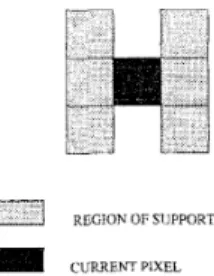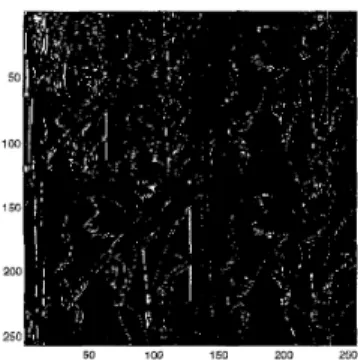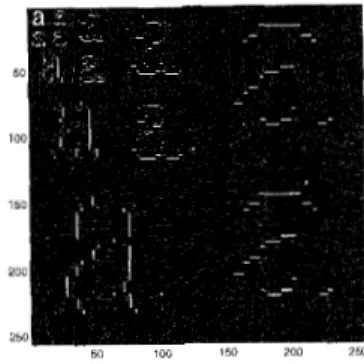Metin Na.fi
Gilrcan,6mer
hT.
Gerek, A. Enis Getin
Bilkent University,
Dept. ofElectrical and Electronics Engineering,
Bilkent,
Ankara,7'R-06533,
TurkeyE-mail:
gurc:an@ee. bilken-t;.
edu.
t rPhone: (90)
312-Zi6 4301Fax:
(90) 312-266 4126
ln this paper a binary waveform coding method hased on morphological subband decomposition coupled with embedded zero-tree and entropy cod- ing is described. This method can be utilized in text compression or bit-plane coding of images. Binary morphological subband decomposition op- erations &re carried oiit in the Galloi~ Fielcl(2), resulting in a computationally efficient structure. Simulation studies are presented.
1. I N T
The subband decomposition is frequently used in coding and pattern recognition applications. 'I'm clitionally, linear filters with perfect reconstruction
(PR) property are employed for the decomposi- tion.
A
nonlinear subband decomposition method for lossless image coding based on ernbedded zero- tree structure is described in [l]. The key idea is t o replace the linear filters in a classical subband de- composition scheme with nonlinear filters. If the input image is binary then such a decomposition can yield non-binary images, which may lead to higher compression ratios. In this paper, a nonlin- ear binary waveform coding method is developed. In this method, arithmetic operations itre carried out in Gallois Field-2( GE'(2)), hence the 'subband' images will be binary. This Nonlinear Binary Sub-bond Decomposition (NUSD) can be used for c-od-
This work 1s supported by TUBITAK (Turkish Scien
_ _ _ _ ~ _ - -
--I.Itific and Technical Research Couiicd) Grant No COS'L'
249, and NSF Grant N o INT-9406954
Multi-resol Decompos
Y
Figure 1: Binary Image Compression Steps
jng of binary images such as two-level texts, hit
planes of images, etc.
The block diagram of the corn
is shown in Fig. 1. The first step is a binary multil-esolutio n image decomposition which can be obtained either by using the
M
wcLvelet t r a n s h
fik.
Both theB W T have the perfect recon The GF(2) arithmetic based
described in Section 2. After the binary subband decomposition, binary subband images at different resolution levtlls are produced. A zero-tree rep- resentation is used l o take advantage of the self similar structure of the multiresolution subimages. This representation, first proposed by Sbapiro [3], is siniilalc t o putting end-of-block marks in block
based transform coding techniques. In our case the decomposed images are binary, therefore a modi
fied form of zero-tree representation is used. The output of this representation has tree symbols
(0,
1, 2). Thcsc s:vrinbols are then binary encoded us-ing Huffman encoding and the resulting bit-stream
is packed into bytes. The coding scheme is ex- plained in Section 3 . Simulation results are pre-
358 TFTS’96
2. BINARY NONLINEAR SUBBAND
DECOMPOSITION
Figure 2: Nonlinear Binary Subband Decomposi- tion
Figure 2 illustrates the nonlinear binary subband decomposition structure. In this scheme, all arith- metical operations are performed in GF(2) which guarantees that the resultant decomposed subim- ages are still binary. An important feature of this structure is that a nonlinear ‘half-band’ filter
M ( I c )
is used instead of linear filters of traditional sub- band decomposition structures [l].Let us review the concept of nonlinear half- band filter. The nonlinear filter & ! is called a non- linear half-band filter, if every other sample of the filter output z is equal t o a multiple of the input signal z > i.e.,
Z ( 2 k ) = cIC(2k) (1)
where
k
is an integer, and c is an arbitrary con- stant. For example, a median filter with the regionof non-compact support shown in Figure 3 can be used as a nonlinear half-band filter as follows:
Z ( 2 k ) = cIC(2k) ( 2 )
( 3 )
z ( 2 k
+
1) = median(z(2k-
a),
2 ( 2 k ) ,4 2 k
+
a ) ,
z ( 2 kt
4)}For instance, 4 3 ) is obtained from
x(O),
.(a),
44)
and 4 6 ) .0 1 2 3 4 5 6
REGION OF SUPPORT
CURRENT PIXEL
Figure 3: Region of Support for 1-D Nonlinear Half-band Filter
REGION OF SUPPORT CURRENT P K E L
Figure 4: Region of Support for 2-0 Nonlinear Half-band Filter
In the decomposition part of the filter bank, the upper branch does nothing but downsamples the input signal by a factor of two. In the lower branch the input signal IC is filtered by I @
M ( z )
where I is the identity operator and M ( x ) is anonlinear half-band filter.
In the reconstruction part, the subsignal 21,
is first upsampled by a factor of two. The up- sampled signal is filtered by the nonlinear filter M ( z ) . The other subsignal,
zh,
is just upsampled by a factor of two. Finally, the resultant signals in the upper and lower branches are added together t o give the reconstructed signal y. With the ap- propriate choice of the nonlinear half-band filter M ( z ) and its region of support the reconstructed signal y is the exact replica of the original signal I C .This statement can be proved following the lines of proof in [5] and noting that none of the opera- tions are field dependent. Hence, the structure in Figure 2 provides perfect reconstruction in GF(2) arithmetic, too.
The proposed decomposition structure can eas- ily be extended t o two dimensions by first perform- ing the decomposition on the rows and then on the resultant columns. An example 2-D nonlinear half-band filter is the median filter with the region of support shown in Figure 4.
The BWT is another binary subband decom- position method. Swanson and Tewfik used this transformation for the subband decomposition of binary images [Z]. The subband images in this de-
composition resemble the binary images obtained by first taking the ordinary wavelet transform of the original binary image and then thresholding the resultant sub-images. The decomposition struc- ture based on the BWT also employs GF(2) arith-
TFTS’96 359
Figure 5: Binary Subband Decomposition of the most significant bit-plane of the L’ena(256x256) image obtained by the Morphological’ Subband De- composition
metic. Figures 5 and 6 show the binairy declom- position of the most-significant bit plane of Lena (256x256) image, which are produced by the NBSD and the BWT, respectively.
3. LOSSLESS CODING O F DECOMPOSED IMAGES,
The subband decomposition produlces sub-band images with a sparse structure as shown in Figures 5 and 6. We propose a modified form of embed- ded zero-tree coding t o compress the decompo’sed images with many zero-valued pixels.
In this method, first the subband images are scanned in a zigzag order, i.e the subbands low- high, high-low, and high-high ( L H l , H L l , H H l ) are examined at the Z-th resolution level. If a pixel with zero value is encountered at loc,ation ( i , j ) in one of the subbands, say X X l then all the pixel values at locations (2’(i-1) t o 2’i7 2’1(j-1> to 2”) in subbands
X X I ,
( b = 1,..
.
,
1 - 1) are checked for zeros. When all these pixels have zero values, the pixel at ( i , j ) is called the root of a zero-tree, de- noted by a symbol ’2’ (or any other value different from 0 or 1). An example zero-tree in a subband decomposed binary image is shown in Figure 7. Finally, the zero-valued pixels which are not roots of zero-trees are represented by ’0’s and all pixels with value 1 are represented by the symlbol ’l’,The zero-embedded coding produces a symbol stream with O’s, 1’s and 2’s. For ;a number of
Figure 6: Bin,sry Subband Decomposition o f the most significant bit-plane of the Lena(256x256) image obtained by the Binary Wavelet Transform sample images, it is observed that the number of 1’s is the smallest and the number of 2’s is the largest. The coding theory suggests that the sym- bols ’2’ and ’0’ should be represented by two bits and the symbol ’1’ should be represented by one bit. Higher compression ratios can be achieved if the resultant bit stream are packed into bytes which are then run-length encoded.
Figure 7: A sample zero-tree
4. SIMULATION STUDIES
The lossless compression scheme was applied t o the compression of binary images. The first such image was the 256x256 pixels binary image of the letter “a.” Fig,ures 8 and 9 show the outputs of the NBSD and BWT applied this image for three times. The NBSD decomposed image was com- pressed 10.8 times with the lossless compression scheme. This result is better than a straightfor- ward Lempel-Zw (LZ) coding which yields a com- pression ratio of 7.19.
360 TFTS’96
50 100 150 200 250
Figure 8: Binary Subba,nd Decomposition of the letter ’a’ obtained by the Morphological Subband Decomposition
icant bit plane of the 256x256 pixels Lena image. This image is created by assigning a 1 to all pixels with values greater than 128, and 0 to all others. Bit plane images are sequentially transmitted in progressive transmission schemes [4]. The most significant bit plane of the Lena (256x256) image can be compressed 3.01 times whereas a direct LZ
coding results in a compression ratio of 2.44. This method can be applied to lossless com- pression of medical images. For 256x256 pixels segment of an 8-bit mammogram image, the first bit plane was compressed 4.70 times while the LZ
compression ratio was 4.00. For the second bit
plane our method’s compression was 4.03 whereas
LZ compression ratio was 4.03. For other bit planes,
LZ compression resulted in higher compression ra- tios. The overall lossless compression ratio is ??.?.
5 . CONCLUSION
In this paper, we describe a nonlinear binary sub- band decomposition scheme and develop a lossless image compression method based on this decom- position. The compression scheme makes use of a modified form of embedded zero-tree coding. The simulation studies show that the proposed decom-
position structure coupled with embedded zero-
tree coding result in better coding ratios than the Lcmpel-Ziv coding method.
In this study, we only used the median filter as the building block of the nonlinear subband de- composition structure. Other nonlinear filters can
Figure 9: Binary Subband Decomposition of the letter ’a’ obtained by The Binary Wavelet Trans- form
also be used. The effect o f t h e filter on the com- pression ratio will be investigated in future work. Another important factor that should be re- considered is the current bit-compression scheme. Instead of grouping bits and subsequently apply- ing a lossless compression such as run-length cod- ing, a better scheme can be devised. This will also be investigated in the future.
0.
Egger,M.
Kunt, “Embedded Ze- rotree Based Lossless Image Coding,” IEEE ICIP’95, vol. IT, pp. 616-619., June 1995.M. D. Swanson and
A.
PI. Tewfik,“A
BinaryWavelet Decomposition of Binary Images,” submitted to IEEE Trans. Image Processing. 9. M. Shapiro, “Embedded Image Coding Us-
ing Zerotrees of Wavelet Coefficients,” IEEE Trans. on Signal Processing, vol. 41, no. 12, pp. 3445 - 3462, Dec. 1993.
M.
Rabbani, P. W. Jones, Digital Image Compression Techniques, Tutorial Texts in Optical Engineering, SPIE, 1991.0. Egger, W. Li, and M. Kunt, “High Com- pression Image Coding Using and Adap- tive Morphological Subband Decomposition,” Proceedings of IEEE, vol. 83, no. 2, pp. 272- 287, Feb. 1995.



